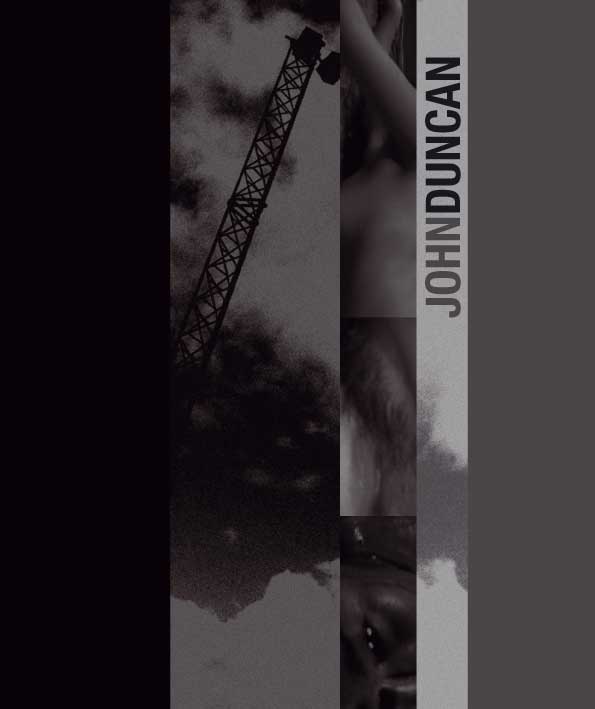
JOHN DUNCAN
Work 1975-2005
Book + CD by Errant Bodies Press
104 pages
ISBN-10: 0-9772594-2-0
ISBN-13: 978-0-9772594-2-7
The Errant Bodies book is a handy document of the many facets of John Duncan's art. Like the VOD33 box set John Duncan FIRST RECORDINGS 1978-1985, it's pretty serious-looking all black and white with a lot of photos, graphics, drawings and explanations/instructions for most of the events that Duncan has devised, including the infamous "BLIND DATE", which for many years sentenced him to exclusion from the Los Angeles avant-garde scene and ruined his private life (read or surf the Internet if you don't know what we're talking about). The book also features eight different essays about Duncan. Aside from one or two misfires, these provide useful and incisive analyses of his work in relation to its cultural and social context (Giuliana Stefani's account of "Blind Date" is just perfect). The accompanying CD contains five compositions dating from 1980 to 2003, which is a good refresher course even for dedicated Duncan-followers: rediscovering the shortwaves and field recordings of CRUCIBLE (Die Stadt) is nice enough, but listening after many years to 1984's fabulous RIOT (AQM) made me realize that many of today's noise gods from Merzbow to Marhaug to Wiese owe Duncan a bottle of wine or three.
-- Massimo Ricci, Paris Transatlantic
The downside of reviewing is of course that within the small piece of text an artists has to be introduced and that doesn't always justify the artist's work. Take for instance John Duncan. Whenever he releases a new work, in such a few lines his whole body of work has to described, but if you are active in the world of experimental music, performance art and installations, and this for over thirty years, it doesn't nearly justify it. This book doesn't paint the complete picture either, but it gets close. His early performances were quite controversial, his work with pornography much rumored and as a musician of the more radical noise music, he was always way ahead of his time. In this book you'll find photo's, text and explanations of his work that will shed more light on his work, than this simple review could do. Apart from texts by various long time close relatives of Duncan, such as C.M. von Hauswolff, Brandon Labelle, Paul McCarthy, Giuliana Stefani also drawings by Leif Elggren and Tom Recchion.
On the CD five pieces, two from the early days, two from the nineties and one from the more recent years. It's interesting to see how the shortwave sounds, Duncan's prime instrument, had developed over the years. In 'Creed', it forms the backbone as well as a radio taped conversation between Duncan and talkshow host Dr. Toni Grant, to the more crude 'Riot' and the refined pieces of later date. Better microphones and means of storage, plus the addition of field recordings make these perhaps to a lesser 'extent' noise, certainly in 'Crucible', but it's certainly nice to hear this development, and which no doubt will continue to develop. Duncan is still a remarkable and still a highly controversial artist, who is one of the big shots in the 'scene'. You could wonder why it took so long to get this book? The only serious omission is that a complete list of work, or discography is not included in this book.
-- Frans de Waard, Vital Weekly
An unstoppable attraction for extreme sounds, in line with the passions that emerged from the international underground at the end of the Seventies, carried John Duncan through complex paths and artistic practices (from Los Angeles to Amsterdam, then Tokyo, then Italy, in Scrutto San Leonardo, Tuscany). More and more contaminated territories, close to a certain kind of performing art which, in the Viennese actionism and body art, the transgressive experiments of Cosey Fanni Tutti (COUM Transmissions, Throbbing Gristle) and the installations-happenings of Paul McCarthy, in California, have their 'noble' ancestors and parallelisms. Investigations where the body has got a pivotal role, a metaphor that spanned all of contemporary art in the last fifty years and which, in John Duncan's case, is modulated according to the chosen expressive media. Duncan has anticipated many post-human tensions, in the alien symbolism of desecrated bodies ('Blind Date'), going through proto-noise musical experiences, exploring frequencies and sound waves ('Riot'), or field recordings ('Crucible') and the first digital urges (in 'Seek' for the 'Mort aux Vaches' series). It's a vast collection representing classic works and mutations, well described in this monographic book by the many protagonists of these and those times, between 'selected artworks', 'audio' (in the included CD), 'installations' and 'performances'. Artistic survival strategies that, purified from the 'emotional' sides and subjected to a sensory remapping, keep their 'radical', 'aesthetic' and 'political' power intact.
-- Aurelio Cianciotta, Neural, Sep 23/2007